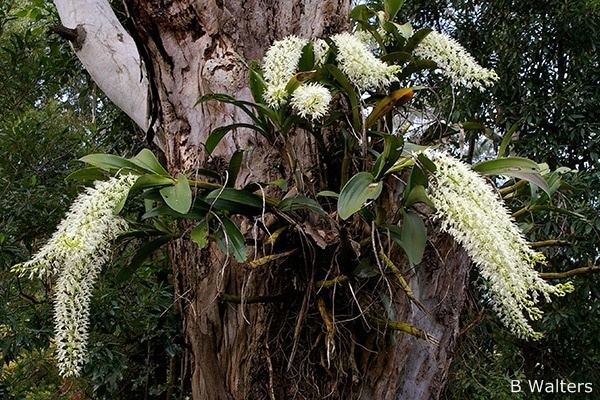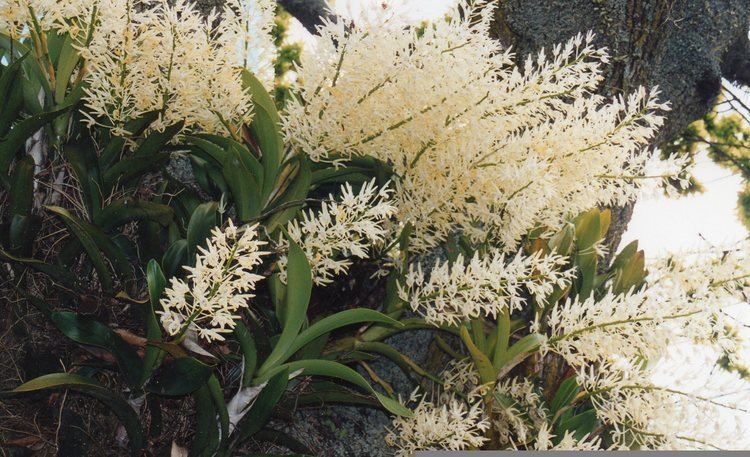Rank Species | Subtribe Dendrobiinae Higher classification Dendrobium | |
Similar Dendrobium, Orchids, Dendrobium kingianum, Dendrobium tetragonum, Dockrillia | ||
Dendrobium speciosum is not only a widespread Australian orchid but also a very variable orchid, forming a species complex. Its varieties can be found in wildly varying habitats as an epiphyte (on branches of rainforest trees) or a lithophyte (on sandstone in open forest) in a continuous distribution along the east coast of Australia and in distinct populations along the Tropic of Capricorn. As a lithophyte, it forms gigantic spreading clumps on rocks and cliff faces, often in full sun, with its roots forming dense, matted beds across the rock. It can be found from sea level to mountain tops.
Contents

Orchidweb dendrobium speciosum
Description

There are two to five thick, leathery leaves originating from the top of each pseudobulb. These leaves can remain on the plant for up to 12 years. The erect or curved pseudobulbs are rather large, up to 45 cm long. They are thickest at their base (5 to 7 cm), and often taper towards the apex (3 cm). The showy flowers grow in long racemes on straight or slowly arching, long, starchy stems with over 100 small sweetly fragrant flowers per stem from August to October. Their color varies from white to creamy yellow. The white labellum is covered with purple dots and veined with red and purple. The roasted stems are edible.

This orchid is popular in cultivation, growing into a large specimen that does well outdoors in climates with a mild winter. It may be grown in an open mix, on a sturdy tree with an open canopy, or as a terrestrial in a well-drained position. It requires very bright light to full sun. Watering is year round in moderation. It is very temperature tolerant as long as it is not severely frosted and receives good warmth during the growing season. Even in ideal cultivation conditions it may not flower every year, especially so in plants from more southern populations.
Taxonomy

It is known under several common names : outstanding dendrobium, king orchid, and the somewhat misleading rock lily. It was originally named by Sir James Edward Smith (1759–1828) from a specimen found at Port Jackson and sent to him by Surgeon General J White. Synonyms, based on the same type, include :

Dendrobium speciosum is a single variable species, forming a species complex overlapping in a continuum of variations. The following varieties, based on morphological data, have been proposed by Adams et al. (2006)
with two new varieties :
Some plants at the distribution limits especially of var. hillii do not fit a strict varietal description and are best designated by geographical location. Furthermore, all varieties are susceptible to cross pollination, giving rise to intervarietal seeds.
This species complex has been previously described by Dockrill in 1969 and reviewed by several authors (Clemesha 1981a, 1981b, 1986, Clements 1989, Banks & Clemesha 1990 and Adams 1991 )
Pollination
Potential pollinators of Dendrobium speciosum, such as the stingless bee Tetragonula carbonaria, are attracted to the plant by large, cream to yellow, finely segmented, aromatic inflorescences. Flowers vary in size within the six recognised varieties of D. speciosum and are pollinated when visited by bees of appropriate size.
Natural hybrids
Dendrobium speciosum forms a natural hybrid with Dendrobium gracilicaule : Dendrobium × gracillimum. This hybrid has also been described as Dendrobium speciosum var. nitidum F.M.Bailey, , Dendrobium × nitidum (F.M.Bailey) M.A.Clem. & D.L.Jones , Dendrobium speciosum var. bancroftianum Rchb.f. and Dendrobium jonesii Rendle subsp. bancroftianum (Rchb.f.) M.A.Clem. & D.L.Jones .
